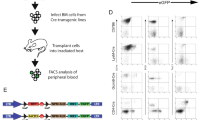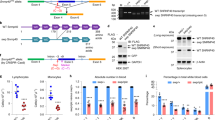Abstract
The T-cell surface glycoprotein, CD4, is expressed predominantly on helper T cells and is thought to play a major role in cell–cell interactions1–5. Monoclonal antibodies against CD4 have been shown to block numerous T-cell functions1,3,4; moreover, recent results suggest that the CD4 molecule may be involved in transmembrane signal transduction6,7. The human CD4 glycoprotein has also been shown to form at least part of the receptor for the AIDS virus, HIV-1 (refs 8–10). Elucidation of the functions of CD4 will be facilitated by the ability to manipulate the protein by genetic means. Because the mouse system is well suited for a variety of functional studies, we have isolated, sequenced and expressed cDNA clones encoding the murine CD4 (L3T4) glycoprotein. Comparison of the mouse and human CD4 sequences reveals striking evolutionary conservation of the cytoplasmic domain, suggesting that this region is essential for CD4 function. In addition, both the human and mouse CD4 gene contain a large intron in the coding region of the V-like domain. As no other members of the immunoglobulin gene superf amily have been shown to contain similarly placed introns, this finding may have important implications regarding the evolution of this gene family in particular and of introns in general.
This is a preview of subscription content, access via your institution
Access options
Subscribe to this journal
Receive 51 print issues and online access
$199.00 per year
only $3.90 per issue
Buy this article
- Purchase on Springer Link
- Instant access to full article PDF
Prices may be subject to local taxes which are calculated during checkout
Similar content being viewed by others
References
Webb, M., Mason, D. W. & Williams, A. F. Nature 282, 841–843 (1979).
Reinherz, E. L. & Schlossman, S. F. Cell 19, 821–827 (1980).
Krensky, A. M. et al. Proc. natn. Acad. Sci. U.S.A. 79, 2365–2369 (1982).
Swain, S. L., Dialynas, D., Fitch, F. W. & English, M. J. Immun. 132, 1118–1123 (1984).
Marrack, P. et al. J. exp. Med. 158, 1077–1091 (1983).
Wassmer, P., Chan, C., Logdberg, L. & Shevach, E. M. J. Immun. 135, 2237–2242 (1985).
Bank, I. & Chess, L. J. exp. Med. 162, 1294–1303 (1985).
Dalgleish, A. et al. Nature 312, 763–767 (1984).
Klatzmann, D. et al. Nature 312, 767–768 (1984).
McDougal, J. S. et al. Science 231, 382–385 (1986).
Hiraki, D. D. et al. J. Immun. 136, 4291–4296 (1986).
Maddon, P. J. et al. Cell 42, 93–104 (1985).
Littman, D. R. et al. Cell 40, 237–246 (1985).
Classon, B. J., Tsagaratos, J., McKenzie, I. F. C. & Walker, I. D. Proc. natn. Acad. Sci. U.S.A. 83, 4499–4503 (1986).
Hood, L., Kronenberg, M. & Hunkapiller, T. Cell 40, 225–229 (1985).
Doolittle, R. Nature 272, 581–582 (1978).
Gilbert, W. Nature 271, 501 (1978).
Marchionni, M. & Gilbert, W. Cell 46, 133–141 (1986).
McKnight, G. L., O'Hara, P. J. & Parker, M. L. Cell 46, 143–147 (1986).
Amzel, L. M. & Poljak, R. J. A. Rev. Immun. 48, 961–997 (1979).
Go, M. Proc. natn. Acad. Sci. U.S.A. 80, 1964–1968 (1983).
Williams, A. F. Immun. Today 5, 219–221.
Swain, S. L. Proc. natn. Acad. Sci. U.S.A. 78, 7101–7105 (1981).
Greenstein, J. L., Kappler, J., Marrack, P., & Burakoff, S. J. J. exp. Med. 159, 1213–1224 (1984).
Biddison, W. E., Rao, P. E., Talle, M. A., Goldstein, G. & Shaw, S. J. J. exp. Med. 159, 783–797 (1984).
Sanger, F., Nicklen, S. & Coulson, A. Proc. natn. Acad. Sci. U.S.A. 74, 5463–5467 (1977).
Classon, B. J. et al. Immunogenetics 23, 129–132.
Altenburger, W., Steinmetz, M. & Zachau, H. G. Nature 287, 603–607 (1980).
Chien, Y. et al. Nature 312, 31–35 (1984).
Maniatis, T. et al. Cell 15, 687–701 (1978).
Author information
Authors and Affiliations
Rights and permissions
About this article
Cite this article
Littman, D., Gettner, S. Unusual intron in the immunoglobulin domain of the newly isolated murine CD4 (L3T4) gene. Nature 325, 453–455 (1987). https://doi.org/10.1038/325453a0
Received:
Accepted:
Issue Date:
DOI: https://doi.org/10.1038/325453a0
This article is cited by
-
Structure and assembly of the sarcomeric M Band
Reviews of Physiology, Biochemistry and Pharmacology (1999)
-
Lack of gp120-induced anergy and apoptosis in chimpanzees is correlated with resistance to AIDS
Apoptosis (1996)
-
Evolutionary relationships of the classes of major histocompatibility complex genes
Immunogenetics (1993)
-
MHC class II interaction with CD4 mediated by a region analogous to the MHC class I binding site for CD8
Nature (1992)
-
Participation of CD4 coreceptor molecules in T-cell repertoire selection
Nature (1991)
Comments
By submitting a comment you agree to abide by our Terms and Community Guidelines. If you find something abusive or that does not comply with our terms or guidelines please flag it as inappropriate.



